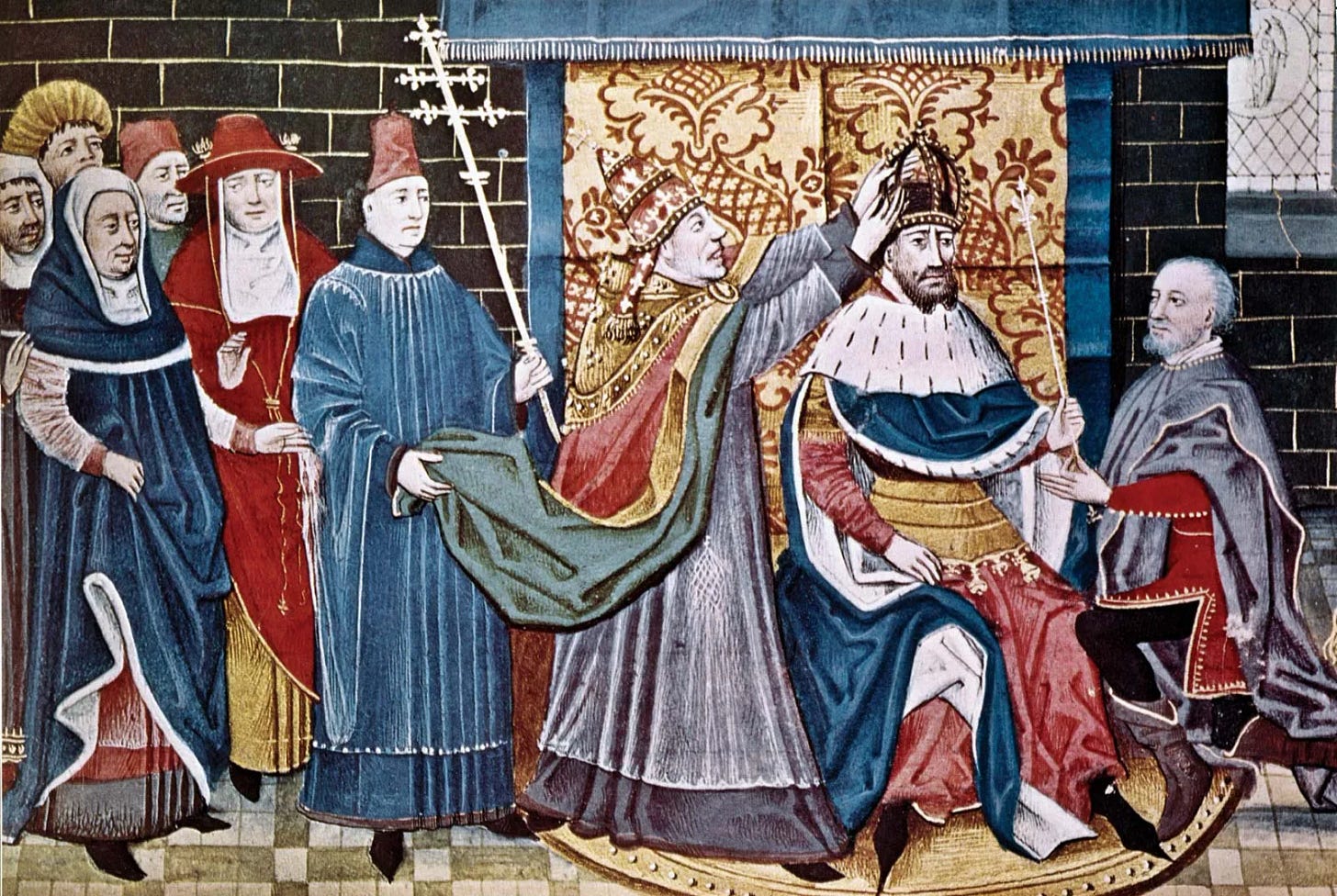

Discover more from Social Studies
I have a two year-old son. Lately, we’ve been teaching him to say “please” after bossing us around. We’ve already succeeded in teaching him some other basic manners, like using a fork to eat instead of his hands. We’re still working on helping him to calm down and try to manage his emotions when they swell up inside of him. Someday soon, we’ll start teaching him not to shit his diapers.
Other than the shitting part, these are not wilderness survival skills. Being polite and using the proper utensils wouldn’t help a toddler being raised in a hunter-gatherer society. Moderating your emotional state would certainly help under certain circumstances — say, hunting game — but would hinder others, like going into battle.
These, rather, are the skills one needs to function in the modern, “civilized” world. As an adult in human society, you can’t go around screaming at people to give you what you want and throwing violent temper tantrums when they don’t comply. You’ll end up, at best, poor and lonely, and more likely, in prison.
At the most basic level, you could call these life skills “cultural capital.” They don’t really function as capital in the way more rarified forms do, like a higher educational credential or a taste for German opera, because almost every adult on earth has more or less mastered them. But at one point in history, they functioned exactly that way.
Norbert Elias’ famous 1939 book, The Civilizing Process, is a sociological history of the development of manners. That’s the logline description of the book, at least. More accurately, it’s a history of the transformation of social power from physical force to cultural virtuosity as a consequence of state formation in Europe. In other words, it’s a history of the development of cultural capital.
That history begins a long time ago. With the collapse of the Roman Empire in the fifth century — which is to say, with the end of civilization for that part of the planet — Europe broke up into a thousand independent fiefdoms. The continent became “governed” by warlords, who conquered the countrysides around them through physical violence and forced their peasant populations into subjugation.
Power and authority, at that time, were pretty straightforward: if you could fight your way into a position of leadership over the other warriors in your realm, you could raise an army and make yourself king. If you genuflected to the Pope, the church would bestow upon you a veneer of moral legitimacy, turning your raw power into political authority. You could pass that authority down to your children, but for their sake, you’d better cultivate the same military skills in them that won you the crown, or their rule wouldn’t last long: they would always face rivals and would-be usurpers in a social order upheld by violence.
In this world, the comportment of the elite conformed to a warrior ethos. One’s physical security depended entirely upon one’s reputation for battle readiness, which meant being primed to fight to the death on a hair trigger. The early medieval knight was a spontaneous, emotional creature, who lived strictly in the present and acted on his impulses. It was a personality that was conducive to the social conditions of that era, and was thus cultivated within the warrior class. The virtue of “honor” that medieval Europe is so famous for essentially boiled down to the understanding that if anyone challenged your social and political status, you would meet them, without hesitation, with overwhelming force (a culture that’s still very much with us in America today.) The prize of “glory” was won in battle through individual acts of heroic violence, which were achieved by transcending one’s normal emotional state and achieving a feverish bloodlust and a reckless abandonment of one’s instinct for self-preservation. These were the values that were embraced and ostentatiously displayed by the aristocracy and nobility of the early Middle Ages. The power, status and safety of these feudal lords depended upon projecting them to their enemies and allies alike.
When we think of medieval court society, we tend to picture the opulence, daintiness and prissiness of, say, the courtiers of Elizabeth I. But in the early Middle Ages, European aristocrats were a much more barbaric bunch. In a society forged and shaped by war, wanton, animalistic violence was not just tolerated but revered. “Outbursts of cruelty did not exclude one from social life,” Elias writes. “They were not outlawed. The pleasure in killing and torturing others was great, and it was a socially permitted pleasure.” Elias quotes a nineteenth century French historian:
“He spends his life,” we read of a knight, “in plundering, destroying churches, falling upon pilgrims, oppressing widows and orphans. He takes particular pleasure in mutilating the innocent. In a single monastery, that of the black monks of Sarlat, there are 150 men and women whose hands he has cut off or whose eyes he has put out. And his wife is just as cruel. She helps him with his executions. It even gives her pleasure to torture the poor women. She had their breasts hacked off or their nails torn off so that they were incapable of work.”
Manners at court, as in the rest of society, reflected this vulgar, brutish existence. Royal courts were, relative to the time, civilized spaces. But even there it was common to spit on the floor and to blow one’s nose into one’s hand at the dinner table. People had to be counseled not to greet others as they urinated or defecated, and the former, at least, was done often in public — on the streets, in hallways, and in the corners of rooms. Knights routinely beat their wives, who would respond, “Most humble thanks. When it shall please you, you may do it again.” People were naked or barely clothed around one another as a matter of course, especially in front of social inferiors. Medieval society had not yet developed the sense of shame around these practices that is so taken for granted today.
But over the centuries, court behavior evolved, until it eventually became the prudish scene of our collective imagination. In the eleventh century, using the right cutlery and chewing with your mouth shut did little to convey the monstrous warrior image one’s aristocratic status depended upon, but by the eighteenth, the court was a place where nobles would be scandalized by the sight of a dining guest cleaning their fork with the tablecloth, or licking the grease off their fingers.
What happened? In two words: state formation.
Behavior in the royal court transformed because the very shape of society had so utterly changed in Europe by the time of the late Middle Ages. The period between the fall of Rome and the rise of capitalism was marked by the centuries-long gestation of what eventually emerged as the modern, unitary, geographically-bounded sovereign nation-state. Like stones by a river, this novel political formation was shaped by the perpetual friction of military conquests by jealous and land-hungry aristocrats, who won wars, lost them, won them again, died, and passed on the tradition to their sons.
Over centuries of constant warfare, the borders of fiefdoms shifted incessantly — but steadily, on the whole, in the direction of consolidation. Stronger warlords defeated weaker ones, taking their kingdoms and then turning their eyes on more powerful rivals, whose domains they would envelop or be enveloped by, as fortune would have it. In the exact same way that capitalist competition moves erratically but relentlessly in the direction of monopolization, over time the military contests of a thousand medieval princes gave way to dominance over the continent by fewer and fewer crowns ruling over larger and larger landmasses.
This was the process of what Max Weber calls “the monopolization of the legitimate use of violence,” or more simply, pacification. As these ever larger territories came under the uncontested rule of ever more powerful royal houses, war became less frequent, and monarchical rule more constant, for the majority of subjects living within them. With the king’s power unrivaled, no longer did land within his territory change hands every generation in some bloody battle between minor nobles. Both physically and legally, only the king, now, could wage war. In an earlier age, petty aristocrats were incessantly hatching plots and raising armies to contest the king’s power. Now, they were reduced to ceremonial roles and titular political offices. They were no longer autonomous agents, but mere servants of the crown. Their aspirations for power could no longer be realistically fulfilled through military force; it could only be achieved by currying favor with the monarch. They were, in Elias’ words, “placed in a kind of monopolistically controlled competition.”
Rivalries that were once settled on the battlefield were now conducted at court, through obsequiousness and favor-trading, marriages and alliances, machinations and subterfuge — the stuff of politics. The royal court became a place of constant surveillance, with vying aristocrats scanning one another for the slightest hint of conspiracy or opportunity. Conversely, it became a place of constant concealment against the prying eyes of rivals.
The master of this political space was no longer the brute who might lop off your head at the mildest insult, but the conniving schemer who could hide any trace of his thoughts or feelings behind an inscrutable poker face. The knight of old times — the hot-headed thug who lived solely in the present — was ill-suited to these new power games, which required rationally plotting one’s every move out into the hypothetical future. Spontaneous psychopathic violence was out. Meticulous emotional restraint and impulse control was now the key to power. These values were celebrated and institutionalized among the nobility of the late Middle Ages as barbarism had been in centuries past. The court became a carefully regulated space, with complex norms and expectations governing how courtiers conducted themselves in every manner of life. A knight could act as a brute in his own castle, but while at court, he was expected to act with courtesy — that is, with restraint, self-regulation and self-denial. “We see how, step by step, a warrior nobility is replaced by a tamed nobility with more muted affects, a court nobility,” Elias writes.
But as military power within these pacified societies became subordinated to the power derived from the mastery of foresight, deception, self-control and strategic planning, a new threat to the aristocracy was emerging: the rising bourgeoisie. Still culturally inferior to the high-born gentry, their increasing financial leverage over the crown earned them entrée into the royal court. There, they competed for rank and status with the aristocrats.
Increasingly unable to compete with the burgher financiers on an economic basis and long deprived of their military power, the gentry, by now well trained in the art of personal comportment, turned to the new aristocratic fashions of taste and etiquette as a way to distinguish themselves from the lowly merchant class. For the aristocrats still had one thing the bourgeoisie did not: leisure time. Their mastery of the trivialities of etiquette demonstrated their pure aristocratic standing by exhibiting just how much idle time they had at their disposal to devote to the lifestyle arts, instead of dirtying their hands in the muck of bourgeois labor.
The bourgeois courtiers, recognizing the new rules of the status contest the aristocrats had established, responded in kind, competing for mastery over the refinement of their manners. The more they succeeded, the more the aristocrats were forced to refine their own behaviors still further, the better to continue to dismiss their bourgeois rivals as vulgar pretenders. Gentile behavior became ever more elaborate, delicate, precious and ostentatious. Status competition in the royal court was now a contest over cultural capital, and cultural capital, along with economic capital, became the new currency of class distinction. The European upper class’ fetishization of manners was the legacy of this class rivalry.
But manners alone couldn’t compensate for the aristocracy’s obsolescence in a pacified society whose economy was shifting to capitalist relations of production. The bourgeoisie prevailed in its rivalry with the feudal aristocracy, and the Industrial Revolution secured its position as the new ruling class. This bourgeois vanguard brought its courtly mannerisms with it into contemporary capitalist society, where, after all, the virtues of rationality, strategic planning, self-discipline and impulse control are imperative to economic success. The etiquette of the late feudal era thrived in the modern one as an instrument of class distinction.
Today, we’re in the midst of another revolution: a digital one. If feudal etiquette resulted from administrative centralization and the condition it created of continuous physical proximity of political rivals in the royal court, the bourgeoisie — or their inheritors, the managers — now exist in an infinitely more diffuse arena, where we compete for status in virtual space with rivals we’ve never met in person and likely never will. Especially in the new work-from-home economy, we can no longer surveil each other’s slightest gestures and facial expressions for signs of threat or opportunity, but we can scrutinize every word and syllable of our rivals’ social media posts for signs of in-group or out-group affiliation. We can’t monitor each other’s table manners online, but we can interrogate the implications of one another’s stated beliefs on social media, drawing wild inferences to expose our enemies’ lack of moral and political sophistication. We can’t readily display our command of etiquette as evidence of our elevated class position, but we can flaunt our understanding of and conformity to the political orthodoxy of the bien pensants.
The cultural capital of taste and etiquette that has persisted since the late Middle Ages has given way to the cultural capital of proper moral and political belief. Social media has become the royal court of the digital era, and social justice dogmas are the table manners of the new managerial class.
Subscribe to Social Studies
Politics, media and social theory
















I find this facinating, but also wonder if the new cultural cache is backfiring. The old class markers had the advantage of bestowing those who held them with traits that may be somewhat neurotic, but ultimately advantageous. The dogged pursuit of higher education, fitness and food obsessions, the ability to track minor social etiquette queues all worked well in advancing one in career or helping one to marry well or both. So being a Cross-Fit, paleo, PhD who is obsessed with 4am wake ups, recycling and driving a Tesla may make you an annoying virtue signaler, it also probably makes you an effective Creative Director or owner of a yoga studio.
The new ettiquette seems to be backfiring. The obsession with equality of outcome over equality of opportunity destroys hard won social gains for some, while benefiting others, causing infighting and disharmony. The increasing loss of any sexual norms (they are oppressive!) is spiraling into increasing hookup culture, medicalization of children under the guise of "gender affirming care" and the further disintigration of marriage and family, an area that was holding strong for the upper classes while the working class has been losing ground for decades. (aka Douglass Murray's "Coming Apart") Concern for the environment has turned into Doomsday Nihlism and is shutting down investment in promising technological solutions like desalinaztion or nuclear power. The fetishization of mental illness has led us down a path of elevating serious disorders into badges of honor. Victimhood over achievement, weakness over strength.
None of this makes you a better member of the upper class. These new cultural signifiers are disintigrating the very markers of success they are supposed to be signaling.
As an anecdotal add-on to my theory, I admit to being a bit of a foodie and also have celiac so I occationally hop into high end specialty markets like Whole Foods or Fresh Market for items I can't find in regular grocery stores. The clientele there was the epitome of the MPC and while there were often some annoying people, they were generally the Beautiful People(tm). Thin, above average attractiveness, dressed in expensive clothes, hair perfectly done, manicured nails... they looked great in yoga pants! Just imagine the exact opposite of People of Walmart.
In the past few years I have noticed.. a change. More disheveled apperances. People whose gender I couldn't really guess. Skin marked with scabs, chipped nails, more obesity. They were still paying $4 for an heirloom tomato and piling into Lexus and Teslas in the parking lot, so I don't think this was a different class of people, just that the class of people had changed. I don't think it's just me. I mentioned this to my husband and he said I was imagining it, but then we stopped into a local high end neighborhood Whole Foods for some gluten free tortila wraps on our way home from his wealthy co-workers BBQ party one evening and he was looking around the store all wide eyed. Then in car said "My bad. WTF!"
Anyway, just a theory. Thanks for the article.
Another interesting piece, and I hope you delve more into this. My son, who has just graduated from Stanford with a humanities degree, said that unless you're doing a STEM degree, the entire purpose of the four years was to teach the students proper etiquette you'll need as a member of the managerial class, and that individual subject matter was very much secondary.